We will look at how China became a leader in artificial intelligence and what we can learn from this example.
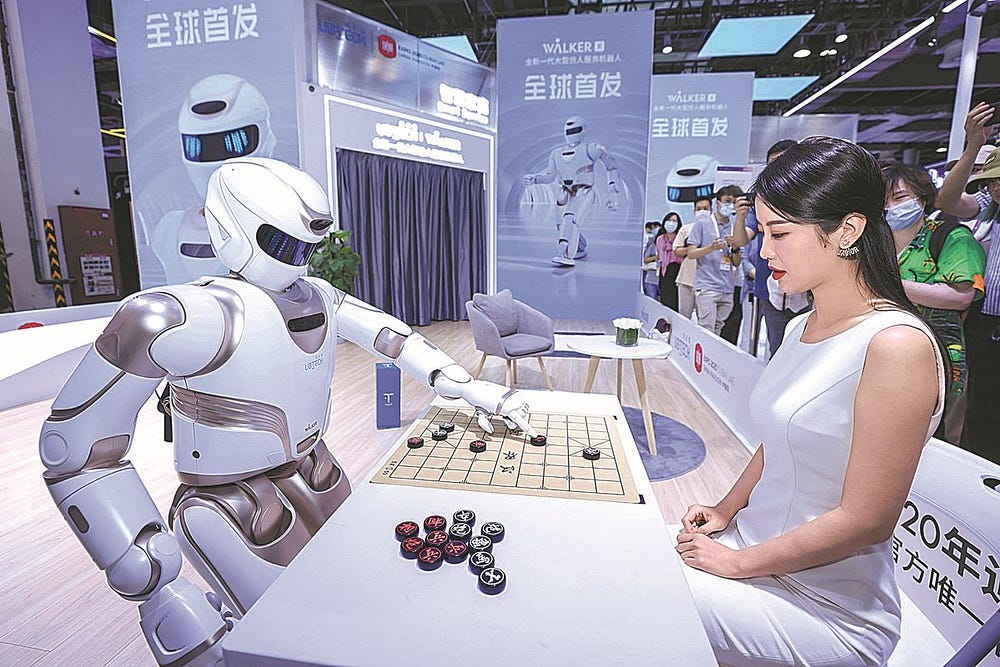
How dependent is China on US artificial intelligence technology?
China’s reliance on U.S. AI technology is significant, despite efforts to develop its own AI industry. U.S.-based AI models like OpenAI’s are not officially available in China, but Chinese companies access them via VPNs and build their software on top of these models. U.S. export controls focus on proprietary AI, but China extensively uses open-source models like Meta’s Llama. While China aims for AI self-sufficiency, its models lag behind U.S. counterparts, and the government is cautious about U.S. AI due to concerns over geopolitical influence. [1]
Even though China lags behind the U.S. for now they are the largest global AI leader and competitor, competing fiercely in AI research, talent, and funding. The 2021 AI Index highlights that China has surpassed the U.S. in AI research impact, though the U.S. still attracts more AI talent. While the U.S. leads in AI funding, China’s public investment is rising. The report suggests that AI competition may shift from a zero-sum game to one involving strategic collaboration, especially in areas like global challenges and AI ethics. [2]
Why China’s edge on AI
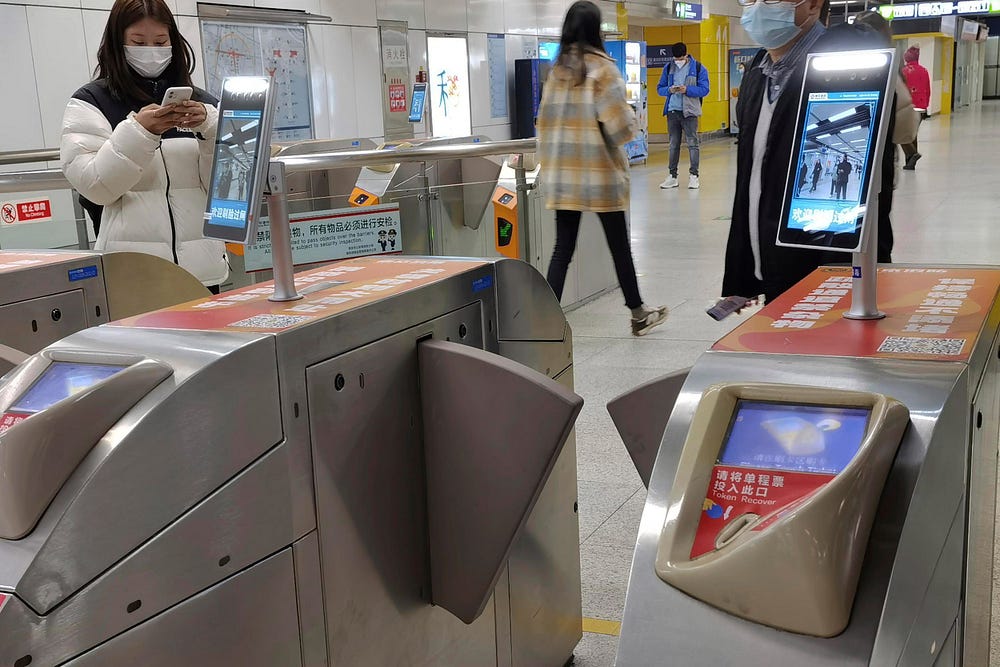
Chinese companies dominated a recent U.S. government ranking of the most accurate facial recognition technology. This success is tied to China’s extensive use of AI, driven by its government’s desire for predictive control over citizens. AI’s reliance on data benefits Chinese firms with state contracts. China’s AI exports are also significant, particularly to autocratic regimes, especially after political unrest. Harvard’s David Yang highlighted this at a symposium on China’s global influence, noting that AI is an exception to the typical innovation lag in autocratic countries. Yuhua Wang discussed China’s “Sovereign’s Dilemma,” where strong rulers face the risk of being overthrown by their elites. This dynamic is evident under President Xi Jinping, who has targeted government insiders in his anti-corruption campaign, leading to signs of internal fragmentation. The symposium also featured discussions on China’s energy extraction history and the human costs of its rapid economic transition. Harvard’s Division of Social Science aims to lead in China-related research. [3]
How did China start to rise in AI?
China’s rise as an AI superpower began in March 2016 when AlphaGo, an AI program, defeated a South Korean Go grandmaster, capturing the attention of over 280 million Chinese viewers. This event spurred the Chinese government’s issuance of an AI strategy in 2017, aiming to make China the global centre of AI innovation by 2030. By the end of that year, China accounted for nearly half of all global AI venture funding. Kai-Fu Lee, a former president of Google China and current CEO of Sinovation Ventures, predicted in his book AI Superpowers that China would surpass the United States in AI development. Although Lee now believes that China and the US are equally strong in AI, he notes that each country has distinct strengths: the US excels in enterprise software, while China leads in manufacturing and image recognition. [4]
Lee explains that AI, particularly deep learning, mimics the brain’s architecture by processing vast amounts of data and computing power. This has led to AI’s ability to replace many white-collar jobs by efficiently processing information and making decisions. He also highlights that China’s rapid advancement in AI is driven by a combination of government support and entrepreneurial energy, which has transformed the Chinese tech sector from imitating US platforms to creating dominant domestic services like WeChat and global phenomena like TikTok. The pandemic has accelerated AI adoption in both countries, with the US seeing increased use of AI in business automation and China utilizing robotics and automated vehicles. Lee foresees significant developments in AI language processing, customized video creation, and the metaverse, where AI avatars will coexist with human avatars. [4]
However, Lee also acknowledges the risks of AI, including the ethical concerns surrounding facial recognition in China and the potential dangers of autonomous weapons like drones. He calls for governments to heed the warnings of AI scientists, similar to how chemists and biologists have spoken out against chemical and biological weapons. Looking forward, Lee predicts that the next wave of technological innovation will focus on deep tech areas such as AI, quantum computing, and blockchain, attracting top talent who might previously have focused on building apps. [4]
Artificial intelligence (AI) is transforming consumption, production, and society, yet many large businesses do not fully grasp its value. In contrast, entrepreneurs and startups, especially in China, are at the forefront of AI innovation, driving advancements in deep learning, sensors, predictive maintenance, and intelligent robotics. China’s AI sector is growing rapidly, fueled by a vast digital user base and a significant increase in AI patents. AI offers the potential to boost productivity and create new markets, with projections suggesting that AI could increase China’s productivity by 27% by 2035, leading to a substantial economic impact. Companies like JD.com, Alibaba, and Tencent are utilizing AI to enhance operations, personalize experiences, and develop new services. [5]
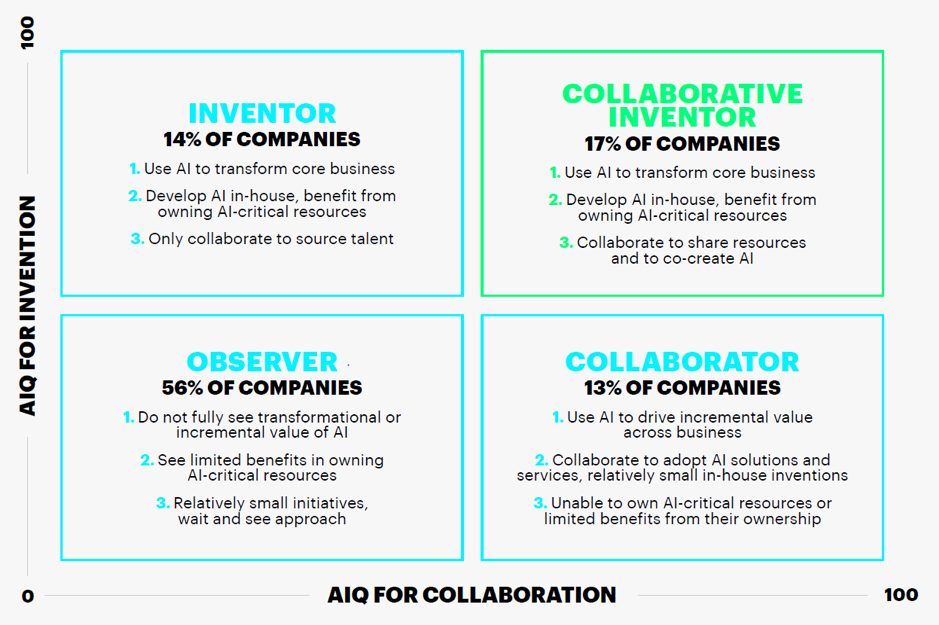
However, successfully leveraging AI requires not just innovation but also scaling these innovations. Businesses must balance investments between core and new products, with only a small percentage of companies excelling in both areas. Companies with high AI capabilities integrate technology, data, and people effectively, creating a collaborative environment that includes diverse talents. China’s AI development is also supported by a multi-stakeholder approach, with initiatives like Baidu’s virtual national lab for deep learning. As AI progresses, there is an emphasis on responsible AI, ensuring transparency, accountability, and fairness, with a focus on augmenting human capabilities rather than replacing them. China’s approach to AI emphasizes the principle of “AI for the people, by the people,” aiming to advance the Fourth Industrial Revolution while keeping human-centric values at the forefront. [5]
Digital technologies and their regulation in China
Chinese companies are global competitors in sectors like e-commerce, ride-hailing, and autonomous vehicles, significantly contributing to national development. Alongside this technological growth, Chinese policymakers have implemented extensive regulations on data and consumer protection, surpassing those in Europe and the U.S. These regulations aim to ensure the ethical use of technologies and prevent market abuses by dominant players. Kendra Schaefer, a tech policy expert, discusses the evolution of digital technologies and regulation in China. She highlights that China’s regulations on AI are among the most advanced globally, particularly in their focus on preventing algorithmic abuses in the labour market. For example, China has implemented regulations to ensure that AI does not violate labour rights, especially in the gig economy, where algorithms manage work schedules for delivery drivers and other workers. These regulations prevent platforms from using algorithms to push workers into unsafe or unfair working conditions. [6]
While China’s AI regulations are broad and proactive, they are still evolving. The initial regulations are general, but they are expected to become more detailed over time. Chinese regulators move quickly to address emerging technologies, often releasing broad guidelines that are refined as they gain more understanding. In terms of global AI regulation, there are divergences in approaches. While there is a shared global concern about AI risks, countries like China, the EU, and the U.S. are developing different regulatory paths. China is advancing rapidly with its regulations, including those on AI-generated content and deepfakes, while the EU is seen as a leader in AI thought leadership in the West. The U.S., however, lags, particularly due to the lack of federal-level privacy and AI protections. [6]
China’s advantages in AI development give its economy a competitive edge
China’s rapid progress in artificial intelligence (AI) development gives its economy a competitive edge, driven by several unique advantages. Recognizing AI as a strategic industry, China already accounts for 61% of global AI patents, narrowing the gap with the U.S. [7]
China’s advantages include:
- Commercial Potential: With the world’s largest internet user base and consumer market, China provides fertile ground for AI commercialization and mass production, particularly in areas like algorithm recommendation and facial recognition. [7]
- Manufacturing Integration: China’s comprehensive manufacturing system supports the integration of AI into various industries, driving digital intelligence upgrades and creating a competitive edge in global markets.[8]
- Talent Pool: China is cultivating a significant portion of the world’s top AI researchers, positioning it to benefit from a growing talent dividend that could further accelerate AI development.[7]
- Energy Resources: China’s strong foundation in new energy, particularly in power infrastructure, photovoltaics, and energy storage, ensures a continuous energy supply crucial for AI development, giving it an additional strategic advantage.[7]
China’s AI Regulations and How They Get Made
China is implementing some of the world's first and most extensive legislation on artificial intelligence (AI). These include regulations governing recommendation algorithms, the most prevalent kind of AI on the internet, as well as new restrictions for synthetically created images and ChatGPT-style chatbots. China's growing AI regulatory framework will redefine how technology is developed and implemented domestically and internationally, affecting both Chinese technology exports and worldwide AI research networks. [8]
However, in the West, China's policies are sometimes dismissed as irrelevant or viewed solely through the prism of geopolitical competition to establish the rules for AI. Instead, these policies warrant close examination of how they will affect China's AI trajectory and what they may teach governments around the world about regulating technology. Even if countries disagree fundamentally on the exact substance of the law, they can learn from one another about the underlying structures and technical feasibility of various regulatory systems.[8]
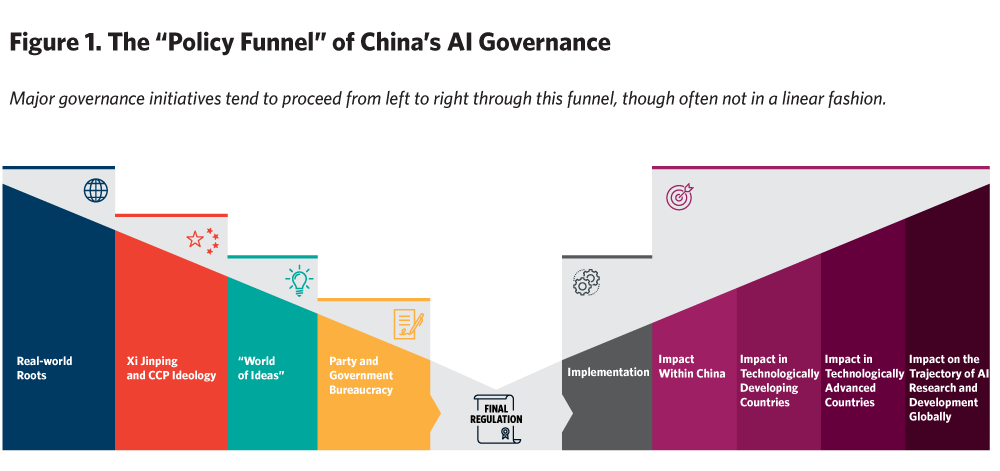
China's three most tangible and influential algorithms and AI policies are the 2021 recommendation algorithm regulation, the 2022 deep synthesis rules, and the 2023 generative AI draft rules. All three laws aim to restrict information, but they also include a number of other regulations. The guidelines governing recommendation algorithms prohibit excessive pricing discrimination and protect the rights of workers who are subject to algorithmic scheduling. Deep synthesis legislation requires prominent labelling to be placed on synthetically generated content. The draft generative AI rule demands both training data and model outputs to be "true and accurate," which could be an insurmountable barrier for AI chatbots to overcome. All three requirements require developers to file a report with China's algorithm registry, a newly established government repository that collects data on how algorithms are trained, as well as to pass a security self-assessment.[8]
The regulations' structure provides lessons for policymakers around the world. Chinese regulators are gradually increasing their bureaucratic know-how and regulatory capabilities by implementing a succession of more tailored AI legislation. Reusable regulatory instruments, such as the algorithm registry, can serve as regulatory scaffolding, making the creation of subsequent regulations easier, which is especially relevant as China prepares to draft a national AI law in the coming years.[8]
Examining the origins of these policies provides insight into the main intellectual and bureaucratic players who shape Chinese AI policy. Recently, the Cyberspace Administration of China (CAC) has been the clear bureaucratic leader in governance, but this position may weaken as regulation shifts away from the CAC's primary skill of online content regulations. Another major stakeholder is the Ministry of Science and Technology, which may see its profile rise as a result of recent government restructuring and a greater emphasis on regulating the underlying AI research. Several think tanks and professors contribute to this bureaucratic rulemaking, most notably the China Academy for Information Communications Technology and Tsinghua University's Institute for AI International Governance.[8]
In the next years, China will continue to implement tailored AI laws and establish the framework for a comprehensive national AI law. Any country, organization, or institution that wishes to compete with, collaborate with, or simply understand China's AI ecosystem must thoroughly scrutinize these initiatives. The following articles in this series will go into the specifics of these policies and how they came to be, enhancing our understanding of Chinese AI governance to date and providing a preview of what is likely to come around the curve.[8]
AI Industry in China
Since its inception in the late 1970s, China's artificial intelligence (AI) business has rapidly expanded into a multibillion-dollar sector, owing to Deng Xiaoping's emphasis on science and technology. Initially lagging behind Western countries because to limited resources and skill, China's AI development has gained traction, particularly since 2006, when the government emphasized AI on its national agenda. Baidu, Tencent, Alibaba, SenseTime, and iFlytek have been acknowledged as leaders in specific AI industries such as facial and speech recognition. AI's quick expansion has had a profound impact on many parts of Chinese society, including the socioeconomic, military, and political spheres, with agriculture, transportation, and manufacturing being the most affected industries. Collaboration between the commercial sector, colleges, and the military is robust, with few limitations. China passed the Data Security regulation, its first national regulation addressing ethical concerns related to AI, in 2021. However, in 2022, the United States implemented export regulations to restrict China's access to advanced AI-related computer processors. Concerns remain regarding the impact of government restrictions on AI development and talent recruiting, particularly given China's demographic concerns. [9]
China’s AI History
China's artificial intelligence (AI) research began in the 1980s, prompted by Deng Xiaoping's emphasis on science and technology for economic development. Early AI attempts were hampered by a conservative cultural outlook and a lack of preceding research, but progress was achieved through government-funded programs and international experts. The Chinese Association for Artificial Intelligence (CAAI) was founded in 1981, with the first notable AI publication appearing in 1987. Since the 2000s, AI development has increased, with China prioritizing AI in national goals and programs. The formation of the Beijing branch of the Association for the Advancement of Artificial Intelligence in 2011, the development of the Wu Wenjun AI Award, and the hosting of the International Joint Conferences on Artificial Intelligence in 2013 were all significant achievements. The 2017 "Next Generation Artificial Intelligence Development Plan" positioned AI as a strategic technology, emphasizing state-private sector collaboration and military-civil fusion. By 2019, AI applications had grown into a variety of domains, including the building of huge language models. The Beijing Academy of Artificial Intelligence launched a large-scale pre-trained language model in 2022, and Huawei released Pangu LLM version 3.0 in 2023. In 2024, China used generative AI to spread propaganda and disinformation through the Spamouflage campaign, as well as a big language model based on Xi Jinping Thought. [9]
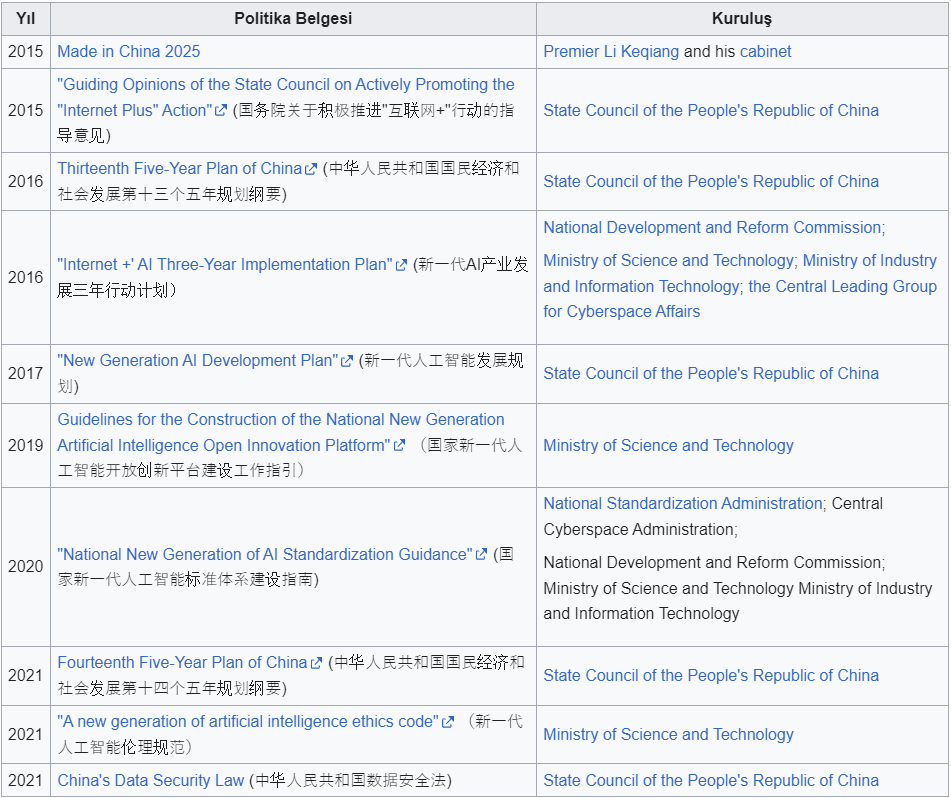
China's AI Government Goals
The Chinese government, under by Xi Jinping, sees AI leadership as critical to future global military and economic supremacy. By 2025, China intends to make important contributions to AI theory and establish itself as a global leader in AI research, propelling industrial and economic development. The government combines state planning with operational flexibility for businesses, thereby protecting domestic AI enterprises while also giving them an international advantage. AI is a primary research focus, with the government investing extensively in AI fields such as face recognition, biotechnology, quantum computing, medical intelligence, and self-driving cars. [9]
AI research and development (R&D) is centred in experimental zones spread throughout 14 cities, with differing priorities based on local industrial requirements. China is a global leader in AI research output, with extensive interdisciplinary cooperation. In 2021, China created the world's largest pre-trained language model. China's massive population creates vast volumes of data, which is critical for AI developments. The country is a leader in facial recognition technology, both domestically and internationally. The Chinese government strictly monitors and supervises AI-generated information to ensure it aligns with CCP doctrine. Companies must follow restrictions that prevent AI from tackling politically sensitive issues. China has restricted access to certain foreign AI resources and employs AI to influence foreign elections through disinformation. [9]
AI's Impact on China
- Economic Impact: AI is predicted to help China's long-term economic growth by lowering operational costs and increasing efficiency, solving concerns such as an ageing population and rising labour prices. However, there are concerns about aggravating income inequality and widening the skills gap, particularly among low- and middle-income workers. AI development is concentrated in coastal regions, which could exacerbate regional economic inequities. Government regulations and support are critical for overcoming challenges to AI adoption, such as high costs and a shortage of skilled workers.
- Military Impact: China aspires to develop a "world-class" military utilizing AI, with a concentration on unmanned weaponry and autonomous vehicles in a variety of fields. China aims to integrate AI for information collecting, decision-making, and operational efficiency, drawing inspiration from US defence tactics. The Military-Civil Fusion Development Commission facilitates tight collaboration between the Chinese military, commercial companies, universities, and government institutions in the development of AI. China's involvement in US AI firms, particularly those with military applications, has sparked national security concerns, prompting limits on foreign investment.
- Academia: Despite China's expanding number of AI research papers, the quality lags, and the country struggles to generate seasoned AI professionals. There are less than 30 Chinese colleges that develop AI professionals, and the experience gap is enormous when compared to the United States. To meet military AI needs, organizations such as the Beijing Institute of Technology have created specific educational programs, including the world's first children's military AI program.
- Ethical Concerns: China has begun to address AI ethics, with the Ministry of Science and Technology establishing rules on AI user protection, data privacy, and security. The Cybersecurity Law and the Data Security Law establish a legislative framework for data management, mandating technology companies to classify and maintain data by tight rules. These policies reflect global concerns about AI ethics, specifically data security.
- Judicial System: Hangzhou's AI-powered Internet Courts employ AI to evaluate evidence and apply legal rules in e-commerce and intellectual property matters. However, questions concerning AI's ability to make unbiased conclusions remain, particularly given the possibility of political monitoring and the removal of problematic cases from public records. Critics argue that artificial intelligence in the judiciary could diminish judicial independence while increasing political control.
Resources
[1] Josh Ye, (9 May 2024), How dependent is China on US artificial intelligence technology?
[2] Sachin Waikar, (8 March 2021), AI Report: Competition Grows Between China and the U.S.:
[https://hai.stanford.edu/news/ai-report-competition-grows-between-china-and-us]
[3] Christy DeSmith| Harvard Staff Writer, (16 March 2023), Why China has edge on AI, what ancient emperors tell us about Xi Jinping:
[https://news.harvard.edu/gazette/story/2023/03/why-china-has-an-edge-on-artificial-intelligence/]
[4] TheGuardian, (2022), TechScape: how China became an AI superpower ready to take on the United States:
[https://www.theguardian.com/technology/2021/dec/08/techscape-china-ai-united-states]
[5] Paul Daugherty, (26 June 2017), How China became an AI leader
[https://www.weforum.org/agenda/2017/06/how-china-became-ai-leader/]
[6] Ekkehard Ernst and Kendra Schaefer,(14 November 2023), The rise of AI in China — Digital technologies and their regulation:
[https://voices.ilo.org/podcast/the-rise-of-ai-in-china--digital-technologies-and-their-regulation]
[7] Cui Chuangang, (25 April 2024), China’s advantages in AI development give its economy a competitive edge:
[https://www.globaltimes.cn/page/202404/1311311.shtml]
[8] Matt Sheehan, (10 July 2024), China’s AI Regulations and How They Get Made:
[https://carnegieendowment.org/research/2023/07/chinas-ai-regulations-and-how-they-get-made?lang=en]
[9] Wikipedia, (8 August 2024), Artificial intelligence industry in China:
[https://en.wikipedia.org/wiki/Artificial_intelligence_industry_in_China]


0 Comments